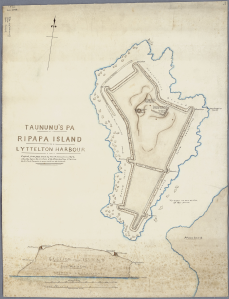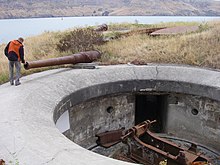Ripapa Island
| Ripapa Island | ||
|---|---|---|
| Ripapa Island | ||
| Waters | Lyttelton Harbor | |
| Geographical location | 43 ° 37 '12.9 " S , 172 ° 45' 16.5" O | |
|
|
||
| length | 170 m | |
| width | 100 m | |
| Highest elevation | 14.3 m | |
| Residents | uninhabited | |
| main place | Fort Jervois (historic) | |
| Map (1872) | ||
Ripapa Island , also Ripa Island , is an island off the coast of Lyttelton Harbor near Christchurch on the South Island of New Zealand .
Pre-European history
A fortified settlement ( Pā ) was built on the island in the early 19th century under Chief Taununu by Iwi Ngāi Tahu . In the 1820s, clashes broke out between Taununu and another group of the Ngāi Tahu, known as the Kai Huanga feud. "Kai Huanga" literally means "eating relatives" and refers to the cannibalistic effects of the dispute and the fact that the two parties were made up of close relatives.
The Ngāi Tahu stayed on the island until about 1832. Chief Te Whakarukeruke, who lived on the island at the time, left it to help defend Kaiapoi against Te Rauparaha . After the fall of Kaiapoi, Te Rauparaha overran several Pā on and around the Banks Peninsula , including the fortification on Ripapa Island. The island was not repopulated by the Māori afterwards.
Quarantine station
In the late 19th century, the island was used as a quarantine station for ships arriving from Great Britain. In 1880 the buildings of the quarantine station were used as a prison, especially for residents of the Māori settlement Parihaka in the Taranaki region during their campaign of passive resistance against the surveying and sale of their land by the government. The buildings of the quarantine station were demolished while the military fortifications were being built.
Fort Jervois
Fort Jervois was built in 1886 during the "Russian Scare", a time when a Russian invasion of New Zealand was feared. It is now New Zealand's best preserved fortification from that period. During the First World War it was again manned and one of four defenses of Lyttelton Harbor. During the Second World War it was again garrisoned.
In the fort there is a working BL 8 inch gun , one of 12 preserved worldwide. A BL 6 inch gun was destroyed during the first test shot, the barrel and other parts of the gun were destroyed due to failure of the return mechanism. This gun can no longer be used. There are remains of other guns in two other gun emplacements.
Todays use
Since 1990 the island has been administered by the Department of Conservation . Fort Jervois has been registered with the New Zealand Historic Places Trust as a Category 1 Historic Place since 1991 . There are considerations to restore the island to its state during the Second World War.
Fort Jervois was damaged by an earthquake in June 2011 and was closed to the public for the time being.
Web links
Individual evidence
- ^ The Taranaki Report - Kaupapa Tuatahi . (PDF; 229 kB) Waitangi Tribunal , archived from the original on April 22, 2012 ; accessed on September 24, 2019 (English, original website no longer available).
- ↑ a b c Heritage sites by region - Historic Fort Jervois, Ripapa Island . Department of Conservation , archived from the original on June 7, 2011 ; accessed on September 24, 2019 (English, original website no longer available).
- ↑ Fort Jervois. Historic Place Category 1. In: New Zealand Heritage List / Rārangi Kōrero . Heritage New Zealand Pouhere Taonga , August 22, 1991, accessed September 24, 2019 .




